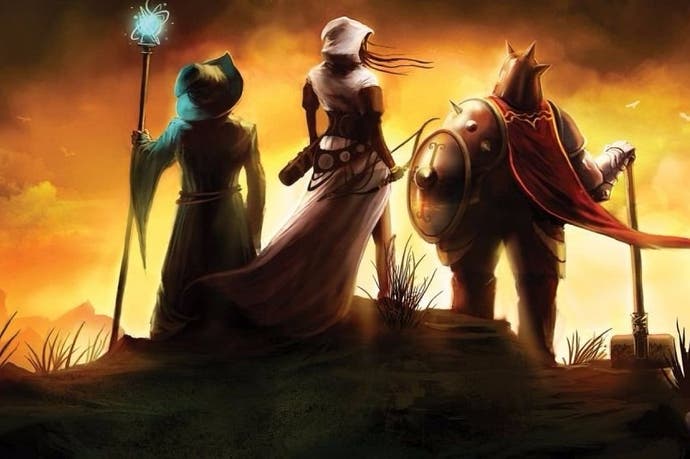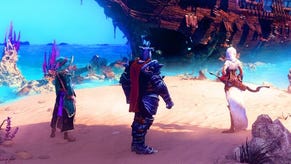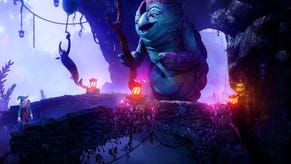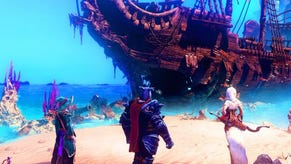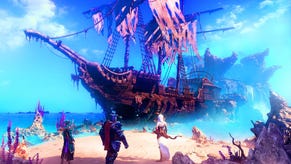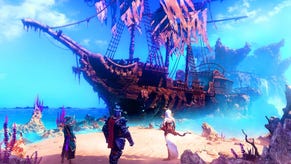Face-Off: Trine 3: The Artifacts of Power
The new PS4 release stacked up against the maxed out PC experience.
With Trine 3, developer Frozenbyte has delivered an impressive title filled with vivid, intricate environments and a variety of accomplished effects work and lighting. The combined use of depth of field, dynamic lighting, and volumetric effects add atmosphere to the game's varied locations, while the move to a true three-dimensional playfield feels like a natural progression to the puzzle-based gameplay seen in previous titles. The use of a full 3D space doesn't always work well, but from a visual perspective we're looking at a significant leap over Trine 2, despite the utilisation of the ageing DirectX 9 API. Of course Frozenbyte has made plenty of optimisations over previous Trine titles, and as a result we see Microsoft's ageing API still putting out a gorgeous release.
Trine 3 is finally available on PlayStation 4, and this version offers up native 1080p visuals along with a 60fps update. However, the game was originally conceived for the PC, and this is the version to beat. Running at 1080p to match the PS4 code, we were able to we maxed out all graphical settings, combining FXAA with 4x SSAA (supersampling) anti-aliasing using a GTX 980 Ti-based system. Our challenge for the PS4 game was pretty straightforward - to see just how close Frozenbyte could get to the title's showing on a top-end PC. Here, clean image quality is joined by lashings of detailed texture work, along with thick volumetric lighting, and extensive use of physics-based interactivity with the environment.
It's a visual treat, but what quickly becomes apparent is that the core experience offered by the PS4 version holds up well, with just a couple of caveats. Sony's console offers up native 1080p resolution, and the use of post-process anti-aliasing provides a clean presentation overall. There's some sub-pixel shimmer, but on the whole there's isn't a huge gulf in image quality between the PS4 and PC versions in this area. In fact, the use of 4x supersampling on PC is basically overkill for this game - the bottom line is that running at native resolution with FXAA alone offers up the vast bulk of the title's visual riches.
It's a good start for the PS4 version but the conversion work isn't flawless, and we find that the presentation is a little let down by vertical lines that appear on some ofo the shadow work. These artefacts aren't particularly visibly in dark areas of the game, but they can be distracting in brighter scenes, and extend to multiple environments across the game - Zoya's white outfit frequently shows up these lines, while they also appear on distant scenery too, slightly reducing the clarity of objects on the horizon.
"Shadows are rendered with (2x2) screen-space dithering," Frozenbyte tells us. "On PC we render to separate render target and filter the result to get rid of the effect. With the PS4 version we didn't have time to implement that."
Texture rendering also appears to have issues in several scenes on PS4, with characters occasionally suffering from pixelation artefacts during a few cut-scenes - something we don't see at all on the PC. These are small anomalies on an otherwise fine looking release, and hopefully Frozenbyte will resolve these small issues in a future patch.
Thankfully, the visuals hold up to a much higher standard elsewhere and Trine 3's vibrant artwork and accomplished use of effects stand out on both versions of the game, with impressive use of lighting, reflections, and depth of field. All of which helps to grab our attention during gameplay.
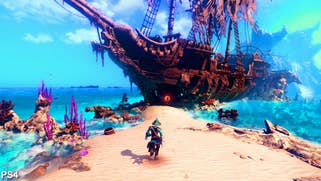
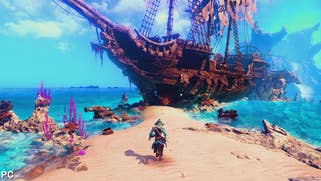
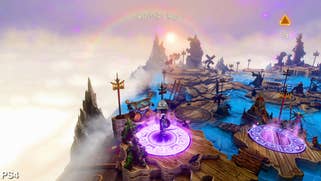
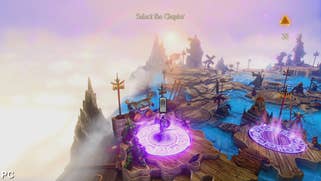
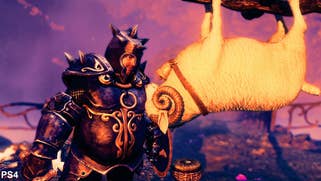

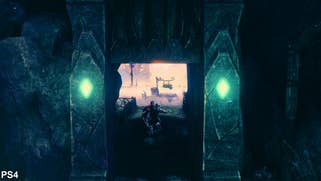
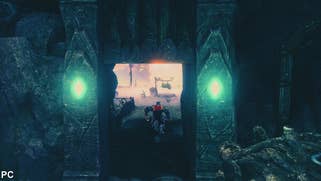
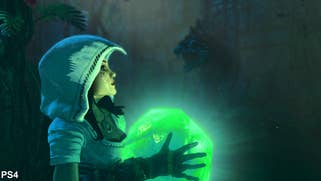


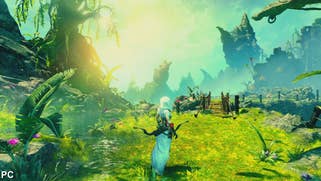
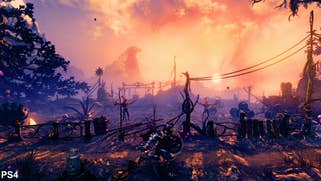
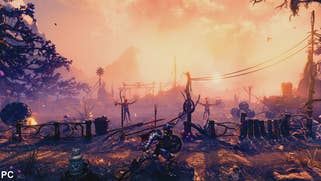
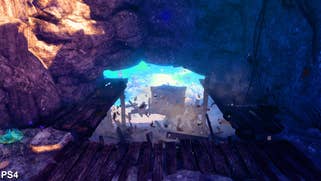
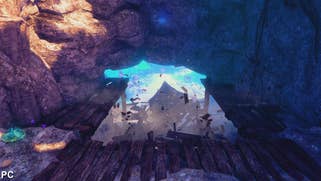
Curiously, asset quality on the PS4 doesn't quite match the PC game running maxed out, which is surprising given the five gigs of system memory available to developers. Lower resolution textures and normal maps are deployed across some surfaces on PS4. Fences, brickwork, and ground textures are all affected to varying degrees. In motion the differences aren't always obvious, only really showing up in side-by-side comparisons, but the PC game definitely features a more refined look as a result.
Another area where the PC version takes point is with regards to lighting. Volumetric effects on both platforms allow for light to scatter more convincingly across the air, producing denser light shafts and a convincing glow across the environment. It really adds a lot of atmosphere to the game, and on the PC these effects appear fuller, covering more of the scene. Meanwhile, shadow quality is also improved on the PC. These elements are rendered at a higher resolution and feature smoother edges. Curiously, foliage on the PS4 casts shadows, but this effect is missing across much of the greenery throughout the PC game. It's an unusual state of affairs that we didn't expect to see given how well the PC version scales up in other areas.
Elsewhere, both platforms deliver an identical range of effects work in various scenes. So character and environment reflections are a match, and we see identical draw distances along with an equally strong use of depth of field across both PS4 and PC. Smoke, particles, and other alpha-based effects are also rendered in full resolution on both versions. And the use of physics-based objects is also equally impressive between platforms.
In terms of performance, Frozenbyte puts in an excellent showing on PS4. Trine 3 runs at a locked 60fps throughout on the platform, and as a result smoothness and controller response remain consistent during both combat and exploration. There are no dropped frames, no tearing, and the gameplay experience really benefits from this fixed level of stability - input latency is low, and the controls feel great. It's a remarkable level of achievement bearing in mind the lush quality of the visuals here, and use of a native 1080p framebuffer.
So overall, the PS4 version of Trine 3 is a nice looking release that holds up well in many areas up against the original PC release. The bulk of the effects work is identical, and the developer's artistic vision isn't compromised by the small anomalies we picked up on. The use of lower resolution textures is surprising, but the core of the game's aesthetic is beautifully recreated on the platform. And performance is locked at a solid 60fps too, which is something you don't see in many games. There's also support for stereoscopic 3D, meaning that 3DTV owners haven't been completely forgotten.
It's not a perfect conversion though, and hopefully the small issues we've picked up on can be addressed in a future update. But right now, if you want the most visually refined experience, the PC version of Trine 3 is the way to go. However, the PS4 release is still a very good-looking game overall, and while there has been plenty of controversy about the overall amount of gameplay you're getting for your money, we had a great time with both versions of this title.
